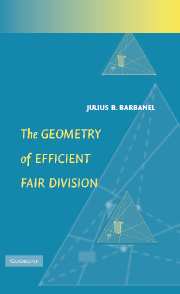In this chapter, we continue to restrict our attention to the two-player context and we consider how the fairness or efficiency of partitions is reflected in the IPS. In other words, if a partition P has some fairness property or some efficiency property, what can be said about the location of m(P) in the IPS? In Section 3A, we consider fairness; in Section 3B, we consider efficiency; and in Section 3C, we consider fairness and efficiency together. In these sections, we assume that measures m1 and m2 on some cake C are absolutely continuous with respect to each other. In Section 3D, we consider the situation when absolute continuity fails.
Fairness
We begin by noting that when there are only two players, proportionality and envy-freeness correspond:
〈P1, P2〉 is a proportional partition if and only if
〈P1, P2〉 is an envy-free partition if and only if
m1(P1) ≥ ½ and m2(p2) ≥ ½
Similarly, strong proportionality, strong envy-freeness, and super envy-freeness correspond:
〈P1, P2〉 is a strongly proportional partition if and only if
〈P1, P2〉 is a strongly envy-free partition if and only if
〈P1, P2〉 is a super envy-free partition if and only if
m1(P1) ≥ ½ and m2(p2) ≥ ½
In Chapter 4, we shall see that these notions are all distinct if there are more than two players.
